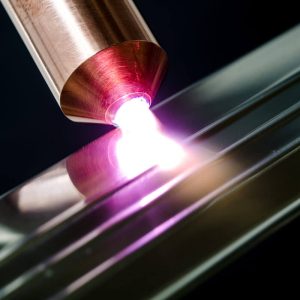Plasma contains highly reactive species including electrons, ions and free radicals. Application of plasma to glass can make it hydrophilic, increase its surface energy and improve wettability, so that inks, paints or adhesives can wet better. In addition, it can remove organic, inorganic and microbial surface contaminants that form due to exposure to air. It can remove release agents, compounding ingredients, monomers and exuded low molecular weight species left by previous processes. Such contaminants can reduce the quality of adhesive bonding by forming a weak intermediate layer. Surface pre-treatment using plasma turns these contaminants to vapour, leaving no residues on the surface.
Plasma can be generated in several ways, including pulsed arc generation and piezo electric discharge, both of which are suitable for glass. Importantly, both these methods work at atmospheric pressure. Treatment with cold plasma avoids wet chemistry and expensive vacuum cleaning equipment and is performed using air or industrial gases such as hydrogen, nitrogen and oxygen. It is a well-established, cost-effective, safe and environmentally friendly process that can help facilitate further applications.

Pre-treatment for glass printing
Glass is well-known for being difficult to print on. Longevity of the printed image can be a problem, so pre-treatment is often integrated into a glass printing process to improve adhesion. You might consider using a liquid primer as a surface pre-treatment to promote the adhesion between the glass and ink, however, these tend to be solvent-based, and require extra processing for solvent evaporation, etc. In contrast, plasma pre-treatment replaces the use of these chemicals (and the associated health & safety and environmental concerns), and can be installed in-line with no appreciable additional production time.
Coating of glass beads
Technologie Anwender Zentrum (TAZ) Spiegelau, part of Deggendorf University, currently uses the Plasmabrush PB3 system to coat glass beads with photocatalytic titanium dioxide layers. The beads are coated under atmospheric conditions by feeding a precursor into the plasma, which is brought into contact with the glass beads to form a fairly uniform homogeneous coating. By adjusting the power and frequency output of the PB3, TAZ are able to optimise their process parameters. The beads will be used in novel filter systems to reduce particles and microorganisms.
Improving adhesion
The Biofluid Mechanics Laboratory at OTH Regensburg has investigated the use of plasma to improve the adhesion between glass and polydimethylsiloxane (PDMS). The laboratory constructs apparatus from materials like these for their experiments ― for example when investigating the fluid and flow behaviour of liquids such as blood. The researchers tested the handheld Piezobrush PZ2 for their application.
If you would like to find out whether plasma pre-treatment is a viable option for your application, please get in touch.
Categories: plasma, surface preparation
